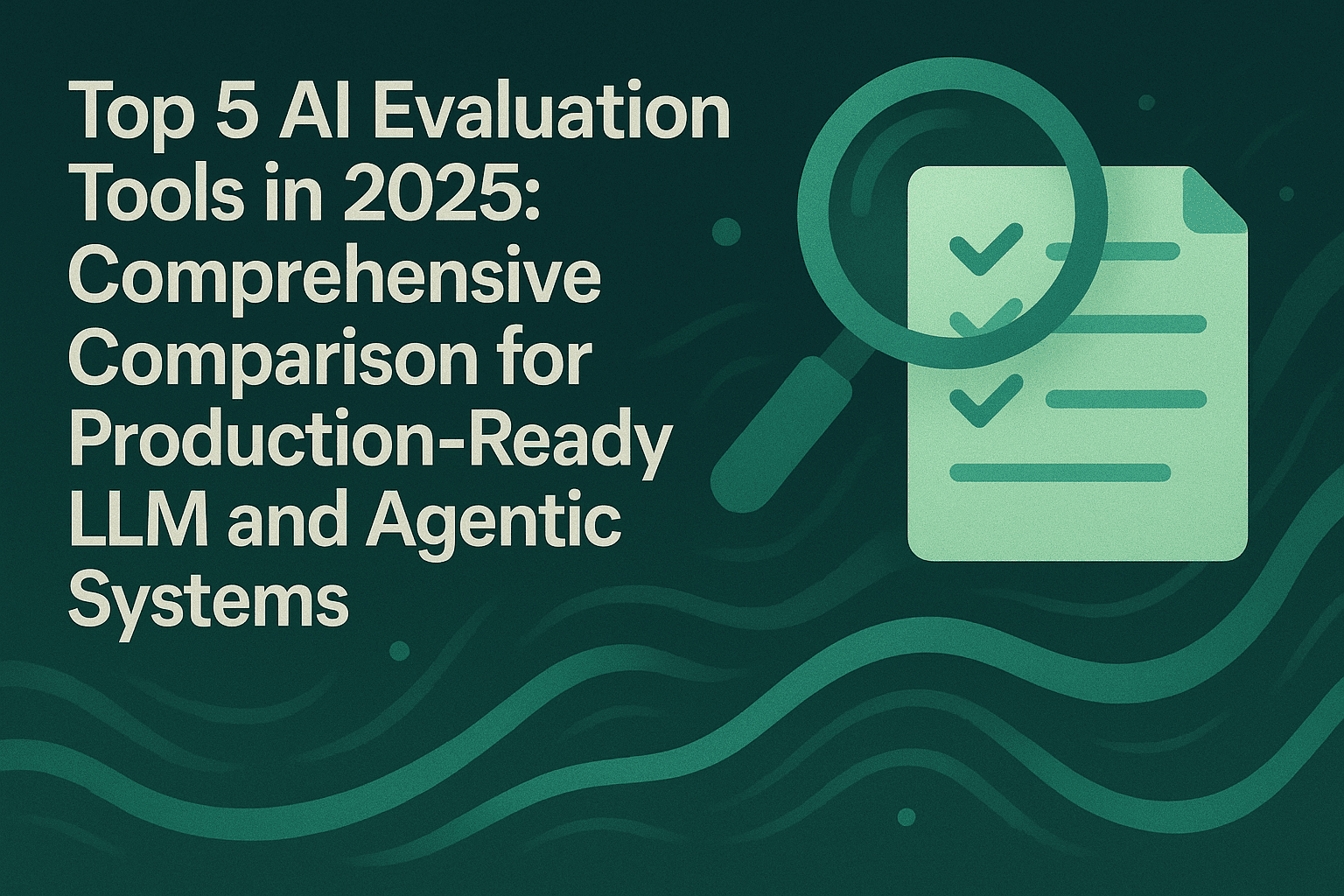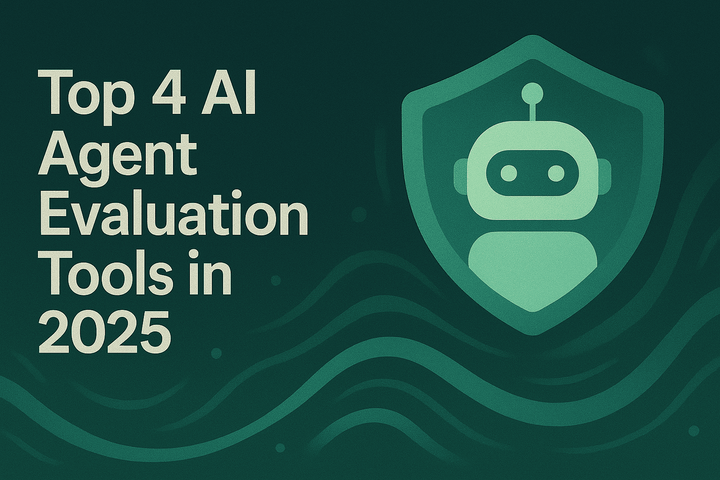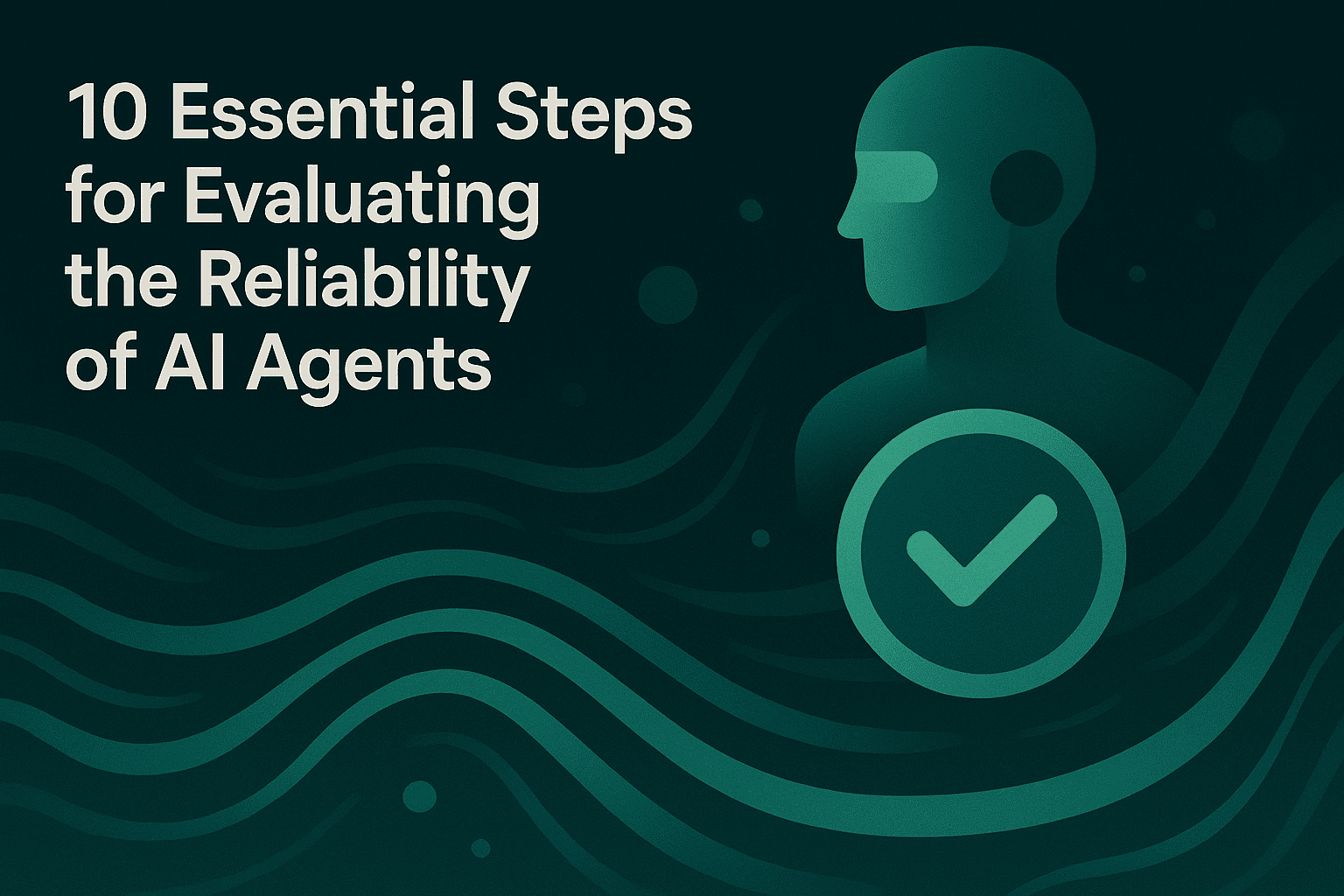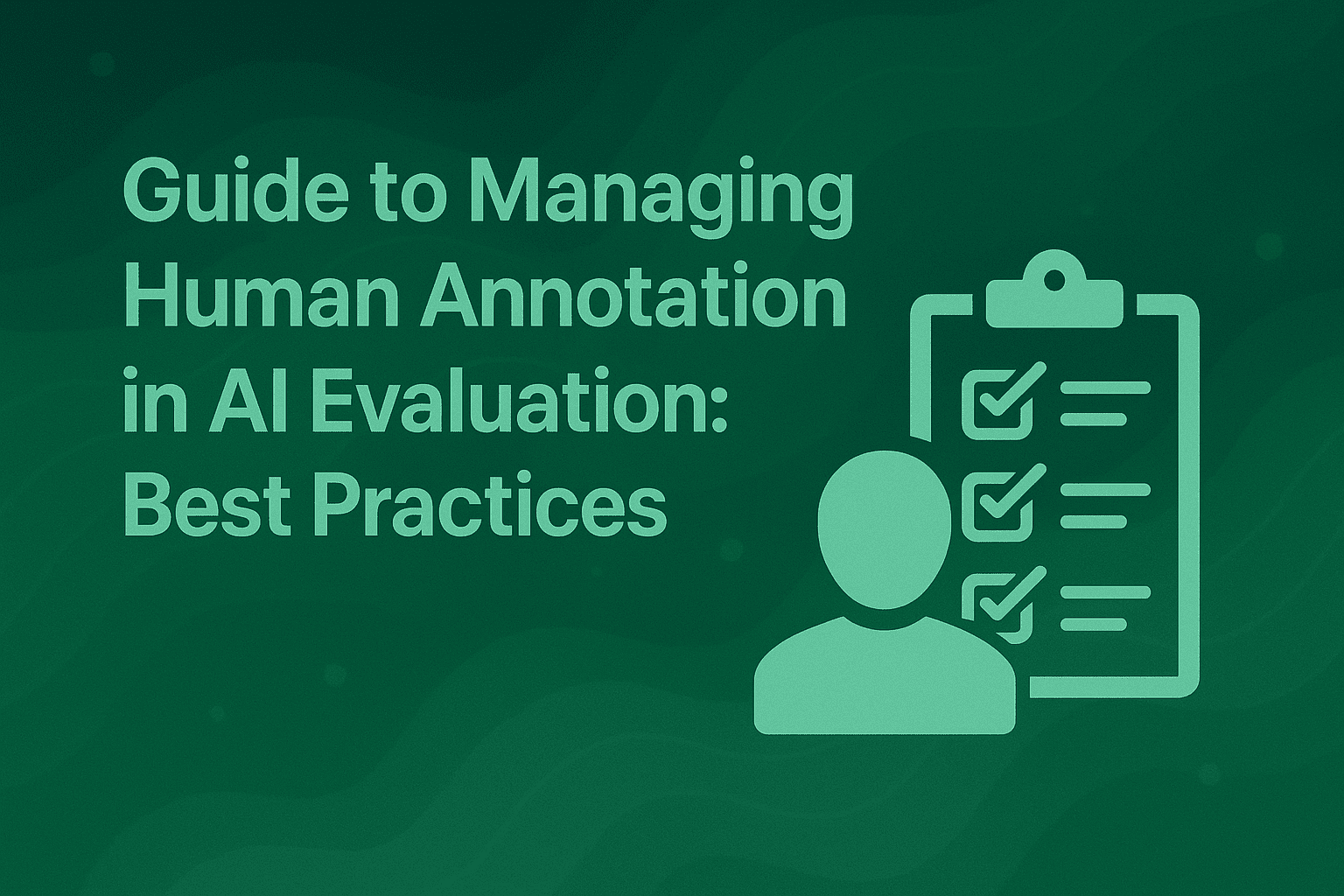Top 5 AI Evaluation Tools in 2025: Comprehensive Comparison for Production-Ready LLM and Agentic Systems

TL;DR
Choosing the right AI evaluation platform is critical for shipping production-grade AI agents reliably. This comprehensive comparison examines the top five platforms: Maxim AI leads with end-to-end simulation, evaluation, and observability for complex agentic systems; Langfuse provides open-source flexibility for custom workflows; Comet Opik integrates LLM evaluation with ML experiment tracking; Arize offers enterprise-grade monitoring with ML observability roots; and Braintrust focuses on rapid prototyping. The right choice depends on your team's needs, whether you prioritize full-stack capabilities, open-source control, enterprise compliance, or experimentation speed.
As AI agents become increasingly mission-critical in enterprise workflows, robust evaluation frameworks have evolved from optional tools to fundamental infrastructure. Research from Stanford's Center for Research on Foundation Models demonstrates that systematic evaluation reduces production failures by up to 60% while accelerating deployment cycles significantly.
The AI evaluation landscape in 2025 has matured beyond basic benchmarking. Modern platforms now offer comprehensive capabilities spanning simulation, offline and online evaluation, real-time observability, and human-in-the-loop workflows. According to MIT's research on AI reliability, organizations implementing structured evaluation frameworks report 5x faster iteration cycles and substantially fewer production incidents.
This guide examines five leading platforms: Maxim AI, Langfuse, Comet Opik, Arize, and Braintrust, providing technical teams with the insights needed to select the optimal solution for their production AI applications.
Why AI Evaluation Platforms Are Essential for Production Systems
Building production-grade AI agents requires more than deploying models. Enterprise teams face critical challenges including maintaining consistent quality across multi-turn interactions, debugging complex agent behavior, ensuring reliability at scale, and meeting compliance requirements. Research from Google's AI Principles documentation highlights that systematic evaluation reduces model drift incidents by 70% in production environments.
The shift from traditional software to agentic systems introduces unique evaluation challenges. Unlike deterministic applications, AI agents exhibit non-deterministic behavior, handle multi-step reasoning chains, integrate external tools dynamically, and operate in open-ended conversational contexts. A comprehensive study by Berkeley AI Research found that 43% of production AI failures stem from inadequate pre-deployment evaluation.
Modern evaluation platforms address these challenges through three core pillars: pre-production simulation and testing that validates agent behavior across diverse scenarios before deployment, real-time observability providing granular visibility into production performance, and continuous evaluation enabling teams to detect and resolve quality degradation promptly.
1. Maxim AI: The End-to-End Platform for Production-Grade Agents
Maxim AI delivers a unified platform designed specifically for teams building complex, multi-agent systems that require comprehensive lifecycle management from development through production monitoring.
Core Platform Capabilities
Advanced Agent Simulation
Maxim's simulation framework enables teams to test agents across hundreds of realistic scenarios before production deployment. The platform supports multi-turn conversation flows, complex tool use patterns, diverse user persona modeling, and multi-agent interaction testing. Teams can simulate customer interactions across real-world scenarios, evaluate conversational quality and task completion, re-run simulations from any step to reproduce issues, and identify failure points systematically.
Research on agent evaluation methodologies shows that comprehensive simulation reduces production issues by 65% compared to traditional testing approaches.
Enterprise Prompt Management
The Prompt Management system provides a centralized CMS with version control, visual prompt editors for rapid iteration, side-by-side comparison tools, and production A/B testing capabilities. Teams can organize and version prompts directly from the UI, deploy prompts with different configurations without code changes, connect seamlessly with databases and RAG pipelines, and compare output quality, cost, and latency across various combinations.
Comprehensive Evaluation Framework
Maxim supports both automated and human-in-the-loop evaluation workflows. The platform provides a rich evaluator store with pre-built evaluators, custom evaluator creation for domain-specific needs, session, trace, and span-level evaluation granularity, and integrated human annotation queues for qualitative assessment.
Teams can access various off-the-shelf evaluators, measure quality quantitatively using AI, programmatic, or statistical evaluators, visualize evaluation runs across multiple versions, and conduct human evaluations for last-mile quality checks. According to Stanford research on evaluation frameworks, combining automated and human evaluation improves agent quality metrics by 40%.
Production-Grade Observability
Maxim's observability suite delivers node-level tracing with visual trace visualization, OpenTelemetry compatibility for standard integration, real-time alerting via Slack and PagerDuty, and support for all major agent frameworks including OpenAI, LangGraph, and Crew AI.
The platform enables teams to track and debug live quality issues, create multiple repositories for different applications, measure in-production quality using automated evaluations, and curate datasets easily for ongoing improvement. Distributed tracing capabilities ensure complete visibility into complex agent execution paths.
Enterprise Security and Compliance
Maxim provides SOC2, HIPAA, ISO27001, and GDPR compliance certifications, fine-grained role-based access control (RBAC), SAML/SSO integration for enterprise authentication, comprehensive audit trails, and flexible deployment options including in-VPC hosting.
Unique Differentiators
Cross-Functional Collaboration
Maxim bridges the gap between engineering and product teams through highly performant SDKs in Python, TypeScript, Java, and Go alongside an intuitive UI that enables non-technical users to drive the AI lifecycle. Product teams can run evaluations directly from the UI, configure evaluations with fine-grained flexibility, and create custom dashboards for deep insights into agent behavior.
Advanced Data Management
The Data Engine provides seamless multi-modal dataset management with capabilities to import datasets including images, continuously curate datasets from production data, enrich data using in-house or managed labeling, and create targeted data splits for evaluations.
Flexible Deployment and Pricing
Organizations can choose between cloud-hosted or in-VPC deployment based on security requirements, with usage-based and seat-based pricing models accommodating teams of all sizes from scaling startups to large enterprises.
When to Choose Maxim AI
Maxim AI is optimal for teams building complex, multi-agent production systems requiring end-to-end lifecycle management, organizations needing seamless collaboration between technical and non-technical teams, enterprises requiring comprehensive compliance and security controls, and teams prioritizing speed and reliability in shipping AI agents.
Learn more about Maxim AI's platform capabilities or schedule a demo to see the platform in action.
2. Langfuse: Open-Source Observability for LLMs
Langfuse has established itself as a leading open-source solution for teams prioritizing transparency, customization, and self-hosting control in their LLM observability stack.
Key Capabilities
Langfuse delivers comprehensive tracing for visualizing and debugging LLM calls, prompt chains, and tool usage patterns. The platform's flexible evaluation framework supports custom evaluators and prompt management workflows, while built-in human annotation queues enable structured review processes.
As an open-source platform, Langfuse provides full control over deployment environments, complete data sovereignty, and deep integration capabilities with custom workflows. This transparency makes it particularly valuable for teams building proprietary LLMOps pipelines or operating in regulated industries with strict data governance requirements.
Ideal Use Cases
Langfuse excels for organizations with strong developer resources who can leverage its customization capabilities, teams requiring self-hosted deployments for data sovereignty or compliance, and companies building custom evaluation frameworks that extend beyond standard tooling.
3. Comet Opik: Unified Experiment Tracking and LLM Evaluation
Comet Opik extends Comet's established ML experiment tracking platform into the LLM evaluation space, creating a natural integration point for data science teams already invested in the Comet ecosystem.
Core Features
The platform provides comprehensive experiment tracking to log, compare, and reproduce LLM experiments at scale. Integrated evaluation capabilities support RAG workflows, prompt optimization, and agentic system testing. Custom metrics and dashboards enable teams to build domain-specific evaluation pipelines, while collaboration features facilitate sharing results and insights across distributed teams.
Best Fit Organizations
Comet Opik is particularly well-suited for data science organizations seeking to unify LLM evaluation with broader ML experiment tracking infrastructure, teams with existing Comet investments looking to extend into LLM workflows, and organizations prioritizing experiment reproducibility and governance across traditional ML and generative AI projects.
Detailed Maxim vs Comet comparison provides additional insights into platform differences.
4. Arize: Enterprise ML Observability Extended to LLMs
Arize brings robust ML observability capabilities to the LLM domain, focusing on continuous performance monitoring, drift detection, and real-time operational alerting.
Platform Strengths
Arize delivers granular tracing at session, trace, and span levels for complete LLM workflow visibility. Advanced drift detection capabilities identify behavioral changes over time, while real-time alerting integrates with Slack, PagerDuty, and OpsGenie for immediate incident response.
Specialized evaluators for retrieval-augmented generation (RAG) and multi-turn agent interactions address complex evaluation scenarios. Enterprise compliance features including SOC2, GDPR, and HIPAA certifications, along with advanced RBAC controls, meet stringent security requirements.
Target Enterprises
Arize serves enterprises with mature ML infrastructure seeking to extend proven monitoring and compliance frameworks to LLM applications, organizations requiring sophisticated drift detection for production AI systems, and teams needing enterprise-grade alerting and incident management for AI operations.
5. Braintrust: Rapid Experimentation Platform
Braintrust positions itself as an experimentation-focused platform for teams prioritizing rapid prototyping and iteration in early-stage LLM application development.
Core Offerings
The platform's prompt playground enables rapid prototyping and testing of LLM prompts and workflows. Performance insights and human review capabilities support monitoring and iteration on model outputs. The experimentation-centric design optimizes for teams moving quickly from concept to initial testing.
Considerations
As a closed-source platform, Braintrust offers limited transparency and customization compared to open-source alternatives. Self-hosting capabilities are restricted to enterprise plans, which may not suit organizations with strict data residency requirements. Teams should evaluate the platform's observability and evaluation capabilities relative to more comprehensive solutions, particularly for production deployment scenarios. The cost structure features a limited free tier, with pay-per-use pricing that may become expensive at scale.
Best For
Braintrust serves teams in early-stage LLM application development prioritizing experimentation speed, organizations comfortable with proprietary platforms, and projects where comprehensive production observability is not immediately critical.
Comparative Analysis: Selecting the Right Platform
Feature Comparison
End-to-End Lifecycle Coverage: Maxim AI provides the most comprehensive coverage spanning simulation, evaluation, experimentation, and production observability. Langfuse and Arize focus primarily on observability with evaluation capabilities, while Comet Opik emphasizes experiment tracking. Braintrust concentrates on rapid experimentation and prototyping.
Enterprise Requirements: Both Maxim AI and Arize deliver robust enterprise features including comprehensive compliance certifications, advanced RBAC, and flexible deployment options. Langfuse offers self-hosting for data sovereignty. Braintrust's enterprise features are limited to higher-tier plans.
Developer Experience: Maxim AI stands out with SDKs in Python, TypeScript, Java, and Go, combined with a no-code UI for product teams. Langfuse provides strong developer tooling for customization. Comet Opik integrates seamlessly for teams already using Comet. Braintrust emphasizes rapid playground-based experimentation.
Evaluation Capabilities: Maxim AI delivers the most comprehensive evaluation framework with automated, statistical, and human-in-the-loop workflows at multiple granularities. Langfuse and Arize provide solid evaluation features focused on observability. Comet Opik integrates evaluation with experiment tracking. Braintrust's evaluation capabilities are more limited.
Pricing Model: Maxim AI offers flexible usage-based and seat-based pricing suitable for teams of all sizes. Langfuse is open-source with optional managed hosting. Comet Opik follows Comet's pricing structure. Arize and Braintrust use enterprise and pay-per-use models respectively.
Decision Framework
Choose Maxim AI if you need:
- End-to-end platform covering simulation, evaluation, and production observability
- Seamless collaboration between engineering and product teams
- Production-grade agent systems with complex multi-agent workflows
- Comprehensive compliance requirements with flexible deployment
- Fastest time-to-production with reliable agent performance
Choose Langfuse if you prioritize:
- Open-source flexibility and full customization control
- Self-hosted deployments for complete data sovereignty
- Deep integration with custom LLMOps pipelines
- Transparency in platform implementation
Choose Comet Opik if you need:
- Unified tracking across traditional ML and LLM experiments
- Strong experiment reproducibility and governance
- Integration with existing Comet infrastructure
- Data science-centric workflows
Choose Arize if you require:
- Enterprise ML observability extended to LLM applications
- Advanced drift detection and monitoring
- Mature ML infrastructure integration
- Compliance-heavy production environments
Choose Braintrust if you prioritize:
- Rapid early-stage prototyping
- Simple experimentation workflows
- Quick proof-of-concept development
- Minimal initial complexity
Implementation Best Practices
Regardless of platform selection, successful AI evaluation requires several critical practices. Establish baseline metrics early by defining clear success criteria before production deployment. According to Carnegie Mellon research on AI evaluation, teams with established baselines detect quality regressions 3x faster than those without.
Implement continuous evaluation by running automated evaluations on production traffic to detect drift and degradation promptly. Combine automated and human evaluation approaches, as research shows hybrid approaches improve overall system quality by 40% compared to purely automated methods.
Create realistic test scenarios that reflect actual user interactions and edge cases. Studies on agent evaluation demonstrate that diverse scenario coverage reduces production surprises by 60%.
Monitor at multiple granularities from individual spans through complete sessions to build comprehensive understanding of system behavior. Establish clear escalation paths for quality issues with defined thresholds and automated alerting.
The Future of AI Evaluation
As AI systems become increasingly complex and autonomous, evaluation platforms will continue evolving. Emerging trends include multi-modal evaluation for systems handling text, images, audio, and video; enhanced simulation capabilities for testing agents in increasingly realistic environments; and improved interpretability tools for understanding agent decision-making processes.
Integration of evaluation with fine-tuning pipelines will enable automated quality improvement loops. Real-time adaptation mechanisms will allow systems to adjust based on continuous evaluation feedback. Advanced compliance and safety frameworks will emerge as regulatory requirements mature.
Organizations investing in robust evaluation infrastructure today position themselves to scale AI applications reliably and maintain competitive advantages through faster, safer deployment cycles.
Start Building Reliable AI Agents Today
Selecting the right evaluation platform fundamentally impacts your team's ability to ship production-grade AI agents reliably and rapidly. Maxim AI delivers the most comprehensive end-to-end platform for teams building complex agentic systems, combining simulation, evaluation, and observability with industry-leading developer experience and cross-functional collaboration capabilities.
Explore Maxim AI's documentation for detailed technical guides on building robust evaluation workflows, understanding agent quality metrics, and implementing comprehensive observability.
Ready to see how Maxim AI can accelerate your AI development lifecycle? Schedule a demo to discuss your specific requirements with our team, or sign up for free to start evaluating your AI agents today.
Additional Resources
- Understanding AI Agent Quality and Evaluation Frameworks
- Dynamic Metrics for AI Agent Performance Evaluation
- Building Production-Ready Evaluation Workflows
- Maxim vs Arize: Detailed Platform Comparison
- Maxim vs Langfuse: Open Source vs Enterprise
- Maxim vs Braintrust: Comprehensive Feature Analysis
- Maxim vs Comet: ML Platform Integration


